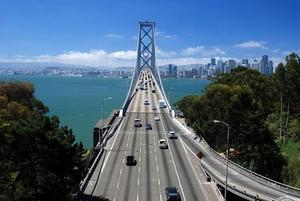InfrastructureBay Bridge repairs expensive, slow
California’s 8-mile San Francisco-Oakland Bay Bridge was designed and built in the 1930s in about 5.5 years at a cost of $78 million, well under budget and ahead of schedule. Presently, the 2-mile eastern span of the bridge needs to be replaced, and it has taken the state five years just to design the replacement. Construction is taking about three times the expected time, and the $6.4 billion budget is almost five times the estimate provided by engineers.

The Bay Bridge from Treasure Island // Source: commons.wikimedia.org
California’s 8-mile San Francisco-Oakland Bay Bridge was designed and built in the 1930s in about 5.5 years at a cost of $78 million, well under budget and ahead of schedule.
Presently, the 2-mile eastern span of the bridge needs to be replaced, and it has taken the state five years just to design the replacement. Construction is taking about three times the expected time, and the $6.4 billion budget is almost five times the estimate provided by engineers.
The Contra Costa Times reports that several reasons can explain the substantial differences in completing the project then and now, and that some of these reasons reflect the changing times. Among the reasons are worker safety, environmental laws, the influence of politics, and project leadership.
“In the 1930s, the bridge itself was the thing people valued, and the engineers and contractors were in charge,” Randy Rentschler, Metropolitan Transportation Commission government affairs director, told the Times. “Since then, the values of our society have shifted 180 degrees, and it is reflected in how long it takes to get things done.”
The original bridge saw twenty-four deaths during its construction, while the development of the replacement span has experienced no deaths. Improvements in safety regulations may have added to costs, but most people agree the costs are well worth it. Tony Anziano, program manager for Caltrans Toll Bridge suggests an expensive regulatory and labor environment may account for the large cost difference between the two projects. Adjusted to today’s dollars using CPI, the 1936 bridge construction would cost $1.3 billion, while the new replacement span has a budget of $6.4 billion. The original bridge project in its entirety employed 8,300 workers, but about 7,700 are building the 2-mile eastern span.
The new span has deeper pilings, beefier foundations, and some of the largest seismic stabilizers used on a bridge anywhere in the world. With 70 percent more structural steel than the old bridge, and a construction schedule set at a time when China’s rapid expansion has increased steel prices, materials are one of the biggest cost drivers in the replacement span.
A comparison of the 8-mile construction in 1936 with the 2 mile replacement span:
- Number of federal, state, and regional agencies needed for permits and other approvals: 13 in 2013, but only 1 in 1936.
- Time to choose a designer for the bridge and award the first bid: 5 years in 2013, but only 2 years in 1936.
- Duration of construction: 11 years if the bridge opens in December 2013, but only 3.6 years in 1936.
- Number of deaths during construction: 0 deaths in 2013, but 24 deaths in 1936.
- Structural steel used: 250,000 tons for the replacement span in 2013, but only 148,000 tons for the 1936 bridge.
- Total cost of the project adjusted to today’s dollars, using CPI: $6.4 billion today, but only $1.3 billion in 1936.
- Total cost per foot of construction: $550,964 for the replacement span in 2013, but only $29,885 for the 1936 bridge.
